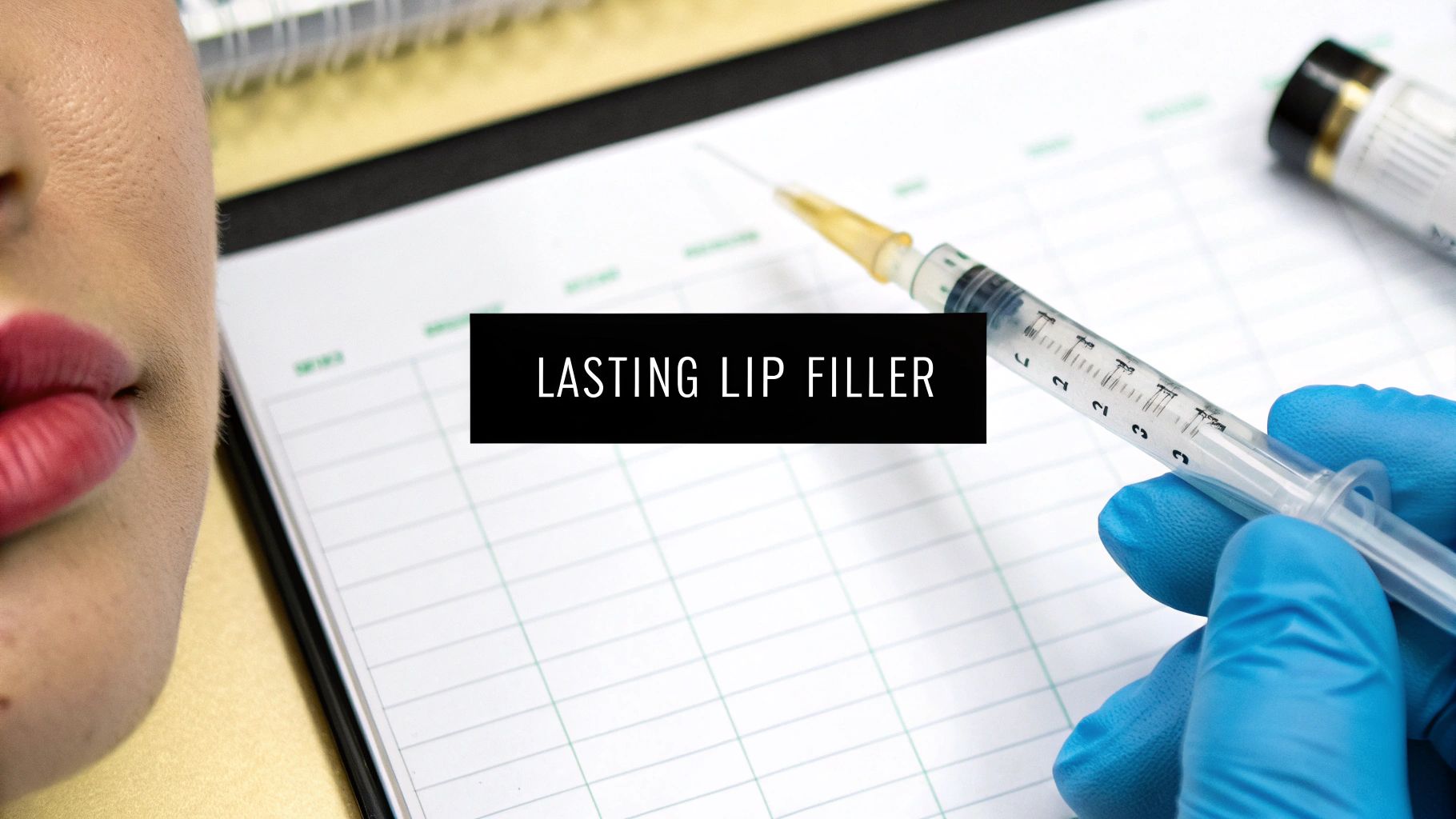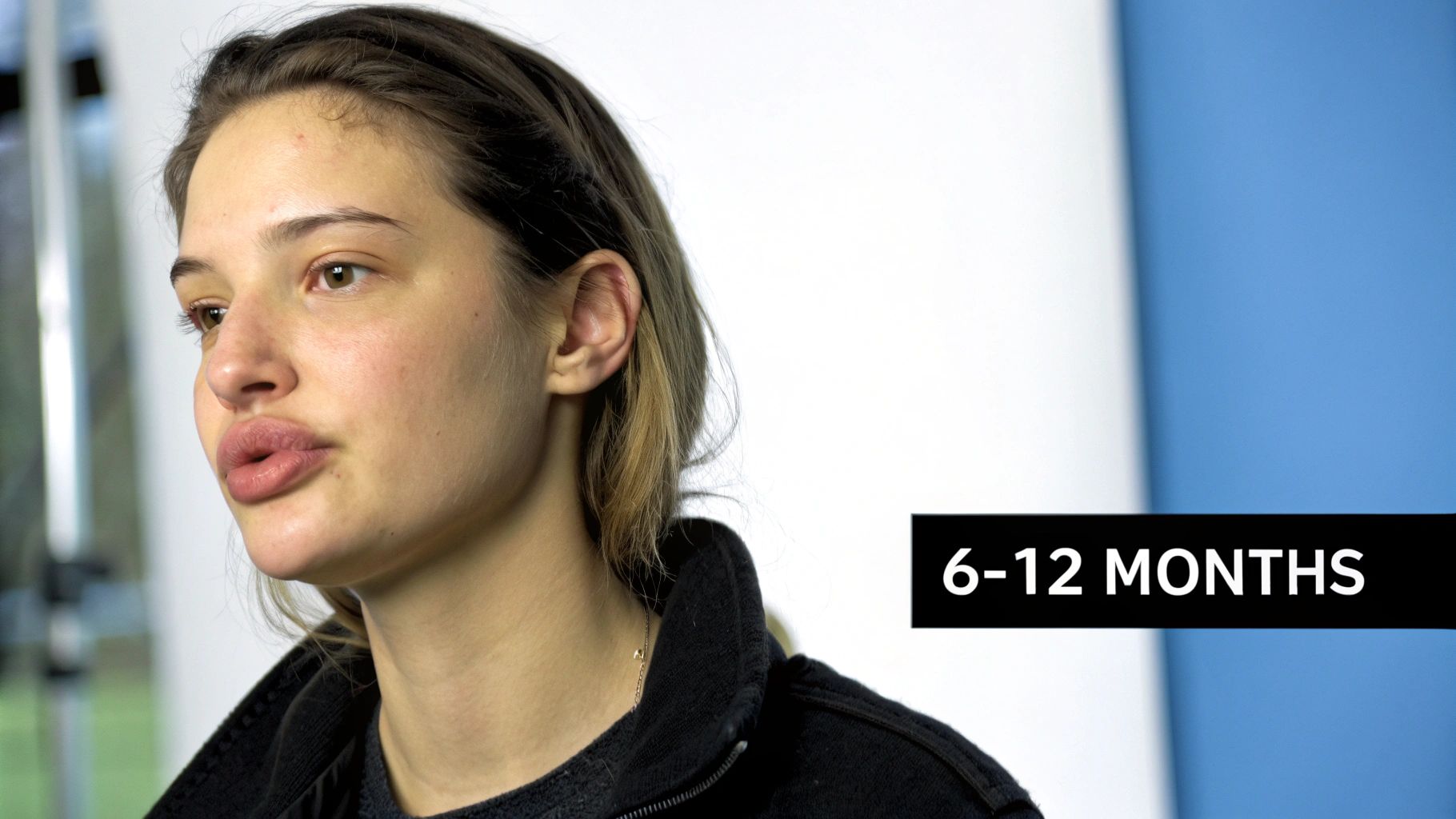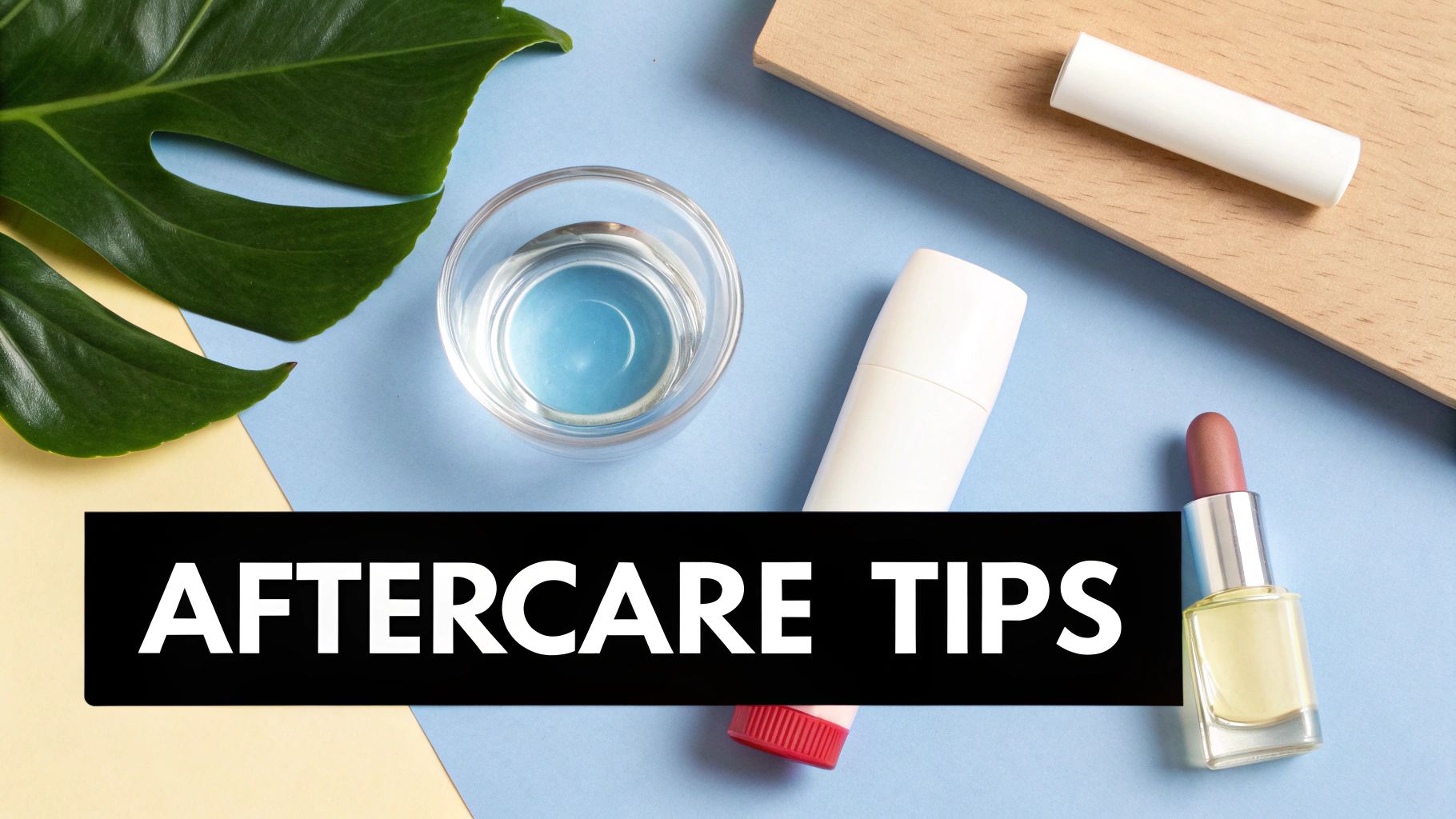
November 24, 2025
How long does lip filler last? Tips for lasting results
Discover how long does lip filler last and the factors that influence it. Get expert tips to extend results and maintain your look.
Nov 24, 2025

When people ask me how long lip fillers last, I tell them to think of it as a range, not a fixed date on the calendar. Generally, you can expect your results to last anywhere from 6 to 12 months.
For some of the newer, more robust fillers, that window can even stretch up to 18 months. But remember, this is just an average. The exact timeline for your lips depends on a few key things: the specific product we choose, your own metabolism, and even your lifestyle.

Knowing what to expect is everything. While that 6-to-12-month figure is a great rule of thumb, it’s not like your filler just vanishes overnight. It’s a gradual, natural process.
The magic ingredient in the most popular lip fillers is hyaluronic acid (HA), which is something your body already makes to keep skin hydrated and plump. Because it’s a natural substance, your body recognizes it and slowly breaks it down over time. It’s a beautiful, and predictable, cycle.
Clinical studies back this up. We typically see the "peak" fullness settle in around 2 to 4 months after the initial treatment. From there, the body’s metabolism gets to work. Research shows that while a whopping 91% of patients are still thrilled with their results at the two-month mark, that number is closer to 74% by six months. These clinical insights on filler duration really highlight why we plan for maintenance appointments to keep that look you love.
This table provides a quick comparison of the typical duration for common hyaluronic acid lip fillers, helping you understand how different products vary in longevity.
Not all fillers are created equal—and that’s a good thing! Think of it like a painter choosing between different types of paint. Some are perfect for a quick, vibrant touch-up, while others are engineered for long-lasting durability. Fillers work the same way. Each brand and product line has a unique texture, density, and structure, which directly impacts how long it sticks around.
Here’s a look at some of the trusted, go-to brands we love working with at Cape Cod Plastic Surgery.
Seeing the options laid out like this makes it clearer why the consultation is so important. The right choice always comes down to your unique lip shape, your skin, and the exact look you’re hoping to achieve. Now, let's dive into the other factors that play a role in making your results last.
To really get a feel for how long lip fillers last, it helps to understand what’s actually going on beneath the skin. The most popular fillers today are made from a substance your body is already very familiar with: hyaluronic acid (HA).
Think of HA as your skin’s own built-in moisturizer. It’s a naturally occurring sugar molecule that acts like a tiny sponge, grabbing and holding onto water—up to 1,000 times its own weight, in fact. This amazing ability is what gives youthful skin its plumpness, bounce, and hydration.
When we inject an HA filler, we're essentially placing that tiny, water-loving sponge right where we want it. It instantly draws in moisture, creating the soft volume that defines beautifully enhanced lips. And because it's a substance your body recognizes, it integrates beautifully and is safely, gradually broken down over time.
Now, you might be wondering: if HA is natural, why doesn't my body just absorb it in a few days? The answer is a clever bit of science called cross-linking.
Imagine raw hyaluronic acid as a handful of loose, individual threads. On their own, they’re pretty flimsy and would be broken down by your body’s enzymes almost immediately. Cross-linking is the process of weaving those separate threads together into a strong, cohesive net. This makes the resulting gel far more durable and resistant to breaking down.
The Analogy of the Net: A filler with a high degree of cross-linking is like a tightly woven fishing net—it’s sturdy, holds its shape, and takes a long time to biodegrade. A filler with less cross-linking is more like a delicate, loosely woven fabric—it’s softer, more flexible, and dissolves much faster.
This is exactly why different fillers have different textures and lifespans. A product designed for subtle hydration like Juvéderm Volbella will have less cross-linking for a soft, natural feel. On the other hand, a filler built for structure and lift, like Juvéderm Voluma, is much more tightly cross-linked to provide lasting support.
This smart variation in cross-linking is what allows an experienced injector to act like an artist, choosing the right "paint" for the right part of the canvas. The lips, which are constantly moving, need a very different kind of filler than the cheeks, which provide structural support for the face.
Here’s a quick look at how this plays out in a real treatment:
This fundamental science—combining water-loving HA with the durability of cross-linking—is the key. It’s why one filler might last six months while another can last well over a year. It's not just about injecting volume; it’s about using sophisticated products to create results that are beautiful, natural, and lasting.
While the type of filler you get sets a general timeline, your own body and lifestyle are the real timekeepers. Think of it like this: the filler is the high-quality paint, but the canvas—your body—and its environment ultimately decide how long that color stays vibrant. Four key factors really influence your personal results.
Knowing what these are is incredibly helpful. It shows you what you can control (like certain lifestyle habits) and what’s just part of your unique biology (like your metabolism). Let's break them down.
Your body's metabolic rate is the single biggest player. Metabolism is simply the process your body uses to break down substances, from the food you eat to the hyaluronic acid in your filler. Just like some people burn calories faster, some people's bodies will process filler more quickly.
This is a totally natural and individual thing. For instance, athletes or anyone with a very active lifestyle tends to have a higher metabolism. Their bodies are just more efficient at breaking down materials, which can mean their lip filler fades a bit faster than it might for someone who is less active. It’s not a good or bad thing; it’s just how your system is wired.
Your metabolic rate acts like a biological clock for your filler. A faster clock means a shorter duration, while a slower one can extend your results. It's the main reason why the same filler can last nine months for one person and a full year for another.
As we've touched on, the filler itself is a massive variable. The science behind fillers involves something called cross-linking, which is basically weaving hyaluronic acid strands together to create a durable gel. How tightly those strands are woven directly impacts how long the product will last. A softer, more flexible filler designed for subtle hydration will have less cross-linking and break down sooner.
On the other hand, a firmer, more structural filler will have a much higher degree of cross-linking, making it more resilient against your body's enzymes. This is why a skilled injector here at Cape Cod Plastic Surgery will spend time discussing your goals. We match the product's properties to the look you want and your expectations for longevity.
Honestly, the skill of the person holding the syringe is everything. An experienced injector has an intimate understanding of facial anatomy and knows exactly where to place the filler for the best look and longest life. The depth of the injection and the amount of product used are absolutely critical.
When filler is placed correctly, it integrates smoothly with your natural tissue, which helps shield it from breaking down too quickly. Poor technique, however, can not only give you uneven results but also a much shorter lifespan for your investment. To get a better sense of why professional expertise is so crucial, you can read our guide on dermal filler side effects.
Finally, your day-to-day life—and even just how much you talk—can affect your results. The lips are one of the most active parts of the face. We’re constantly using them for talking, eating, and making expressions. All that movement naturally contributes to the filler breaking down more quickly than it would in a less mobile area, like the cheeks.
Scientific studies using advanced imaging have actually proven this. Research shows that just 12 weeks after an injection, the lips held onto only about 37% of the initial volume increase. In contrast, less active areas like the midface retained around 79%. That's a huge difference that really highlights how muscle activity speeds things up. Discover more insights about these hyaluronic acid filler findings on news-medical.net.
A few other lifestyle factors come into play, too:
By understanding these four pillars—metabolism, product choice, injector skill, and lifestyle—you get a much clearer picture of what influences how long you can expect to enjoy your new look.
Knowing how long your lip filler will last isn't just about circling a date on the calendar. It's about understanding the entire journey your lips will take. From the moment you hop out of the treatment chair to the day you decide it's time for a top-up, your results go through a few predictable and fascinating stages.
Let's walk through it. Thinking of your filler in phases—the initial swelling, the settling-in period, the peak results, and the gradual fade—takes all the guesswork out of the process. It helps you know what's normal, what to expect, and how to appreciate your beautiful results as they unfold.
Right after your appointment, your lips will be in what we call the swelling phase. This is totally normal and expected. It’s simply your body’s natural response to the injections, and the hyaluronic acid in the filler starts attracting water, which adds to the temporary puffiness. You might also see a little bruising.
It's so important to remember that this initial volume is not your final look. It's common for your lips to seem a bit bigger or feel firmer than you expected for a day or two. The best thing you can do is be patient and stick to the aftercare plan we provide. For a deep dive into navigating this first stage, check out our guide on how to reduce swelling after lip fillers.
This timeline gives you a great visual breakdown of what to expect as your filler settles in and eventually fades.
As you can see, once that initial puffiness goes down, your results will settle, hit their peak, and then slowly taper off over the next several months.
Once the initial swelling and any bruising have disappeared, you’ve entered the settling phase. Honestly, this is where the magic really starts to happen. Over these first few weeks, the filler begins to integrate beautifully with your natural lip tissue, softening and molding into a smooth, seamless result.
By about the one-month mark, the filler is fully settled, and you’re seeing your true, final outcome. That initial firmness has relaxed into a soft, natural texture. The shape and volume you and your injector here at Cape Cod Plastic Surgery carefully planned will be perfectly clear.
Welcome to the sweet spot! During these months, your lip filler is going to look its absolute best. The volume is stable, your lips are beautifully hydrated thanks to the hyaluronic acid, and the results feel completely natural. We call this the "golden window"—the time to just sit back and enjoy your enhanced shape, definition, and fullness.
This is the perfect time to snap some photos. They make a fantastic reference point for future appointments, helping you and your injector pinpoint exactly what's needed for a touch-up to maintain the look you love.
During this peak phase, the filler has fully harmonized with your unique facial features. Your lips will move naturally when you talk and smile, and the enhancement will feel like it’s always been a part of you.
After enjoying that peak period, your body's metabolism will naturally and gradually begin to break down the hyaluronic acid filler. This is a very slow, subtle process—not an overnight change. You won't wake up one morning to find your filler has vanished.
Instead, you might notice a gentle softening of volume or that the crisp definition along your lip line isn't quite as sharp as it was. This gradual return to your baseline is the number one sign that it might be time to start thinking about scheduling a maintenance appointment.

You’ve made the investment in the perfect pout, so of course, you want to protect it and enjoy the results for as long as possible. While you can’t exactly change how fast your body metabolizes things, you have a surprising amount of control over the lifestyle and aftercare habits that impact your filler's lifespan.
Think of your filler like a delicate plant. If you give it the right environment and care, it’s going to thrive. A few simple, consistent actions can make a huge difference in how long your hyaluronic acid filler lasts.
The first 24 to 48 hours post-injection are absolutely crucial. This is when the filler is settling in, and your body is just beginning to heal. Following these initial aftercare steps is probably the single most important thing you can do for a smooth recovery and fantastic, long-lasting results.
Getting these simple steps right lays the groundwork for a great outcome, letting the filler integrate seamlessly without any unnecessary interference.
Once you’re past that initial settling-in period, the focus shifts to your long-term habits. The right practices can protect your filler from breaking down sooner than it should.
The secret to longevity isn't a one-time trick; it's a series of small, consistent habits that protect the filler from environmental and lifestyle stressors, preserving its structure and volume over time.
It really comes down to this: a healthy lifestyle supports healthy skin, which in turn supports your filler. Staying well-hydrated and eating a balanced diet full of antioxidants helps maintain your skin’s overall integrity, creating a much better environment for the filler to last.
Finally, one of the best strategies for long-term happiness with your look is to get on a regular maintenance schedule. Don't wait until your filler has completely disappeared. Scheduling a touch-up when you first notice a subtle dip in volume is a game-changer. This principle of proactive care applies to more than just aesthetics; you can find general expert tips to make products last longer that follow the same idea.
This approach has some real advantages:
Here at Cape Cod Plastic Surgery, we work with every patient to create a personalized maintenance plan. By combining smart aftercare with a strategic touch-up schedule, you can keep your lips looking exactly how you love them, month after month.
You can pick the most expensive, longest-lasting filler on the shelf, but its real potential is unlocked by the person holding the syringe. The best injectors are part artist, part medical professional. It's their in-depth knowledge of facial anatomy, refined injection technique, and understanding of how different products behave that turns a simple gel into a beautiful, natural-looking result.
A seasoned provider knows exactly how much filler to use and precisely where to place it. Proper placement at the right depth in the tissue is key. It ensures the product integrates seamlessly with your lips, moves naturally when you talk and smile, and is better protected from the body's enzymes that break it down. That skilled application is what truly determines the longevity you’re hoping for.
Frankly, choosing the right provider is the single most important decision you'll make. It’s not just about getting a good result—it’s about your safety and finding someone who genuinely listens to your aesthetic goals.
Here’s what to look for when you're searching for an injector:
A good consultation should feel like a collaborative conversation, never a high-pressure sales pitch. It’s your chance to really get a feel for the injector’s expertise and approach, so come ready with questions.
A great injector listens more than they talk. They should be focused on understanding your unique goals and creating a personalized treatment plan designed to achieve results you'll love for months to come.
Here are a few essential questions to get the conversation started:
Choosing a trusted clinic like Cape Cod Plastic Surgery gives you peace of mind. You know you're getting authentic, FDA-approved products and being treated by a professional whose skill is the biggest factor in how long—and how beautifully—your lip filler will last.
To wrap things up, let's go over a few of the most common questions we get from our clients at Cape Cod Plastic Surgery. It's completely normal to have a few lingering thoughts, and feeling confident in your decision starts with having all the answers.
We'll touch on everything from what the treatment actually feels like to what happens if you decide to go back to your natural look. Getting clear, expert answers is the final, most important step.
This is easily the number one question people ask, and the answer is usually a pleasant surprise: it’s much more comfortable than you might think. While everyone has a different pain threshold, we do everything we can to make the experience as gentle as possible.
First, we apply a strong topical numbing cream to your lips, which does a great job of dulling the sensation. On top of that, most modern hyaluronic acid fillers, like those from Juvéderm and Restylane, actually contain a small amount of lidocaine. This is a local anesthetic that works from the inside out as the filler is placed, keeping you comfortable. Most people just feel a bit of a pinch or some light pressure, not outright pain.
Yes, you absolutely can. This is one of the best things about using hyaluronic acid (HA) fillers—they aren't permanent. If you’re not thrilled with the outcome or just miss your original lips, the solution is simple and safe.
We use an enzyme called hyaluronidase, which is specifically made to break down hyaluronic acid. When it’s injected into the area, it gets to work right away dissolving the filler. Within a day or two, your lips will be back to how they were before. Having this "undo button" offers a huge amount of peace of mind, especially for anyone trying fillers for the first time.
Good news here—a maintenance appointment typically costs less than your first treatment. That's because we’re not starting from square one. Touch-ups usually require less product because we're just topping off the volume that has gradually and naturally diminished over time.
The exact price will depend on a few things:
We can give you a clear quote during your consultation and even map out a maintenance plan that works for both your aesthetic goals and your budget.
This is a very common myth, and I’m happy to set the record straight: no, they won't. Your lips won't become stretched, saggy, or wrinkly once the filler metabolizes. They will simply, and gradually, return to their natural shape and size.
In fact, you might even get a little bonus. Studies show that hyaluronic acid fillers can actually encourage your body to produce more of its own collagen in the area. This means that even after the filler has been absorbed, your lips might be left a bit healthier and more hydrated than they were to begin with.
It's a very different process from other cosmetic injectables. For example, our guide on how long Botox lasts explains how neurotoxins work by relaxing muscles, not by adding volume like fillers do.
Feeling ready to take the next step toward the beautiful, natural-looking lips you've been dreaming of? At Cape Cod Plastic Surgery, our team is dedicated to providing personalized care and expert results. Schedule your consultation with us today

November 24, 2025
Discover how long does lip filler last and the factors that influence it. Get expert tips to extend results and maintain your look.

November 24, 2025
Essential Strategies for a Smooth and Safe Post-Surgery Recovery

November 23, 2025
What is Morpheus8 treatment? Discover how this advanced RF microneedling solution revitalizes skin, its benefits, costs, and what to expect from the procedure.